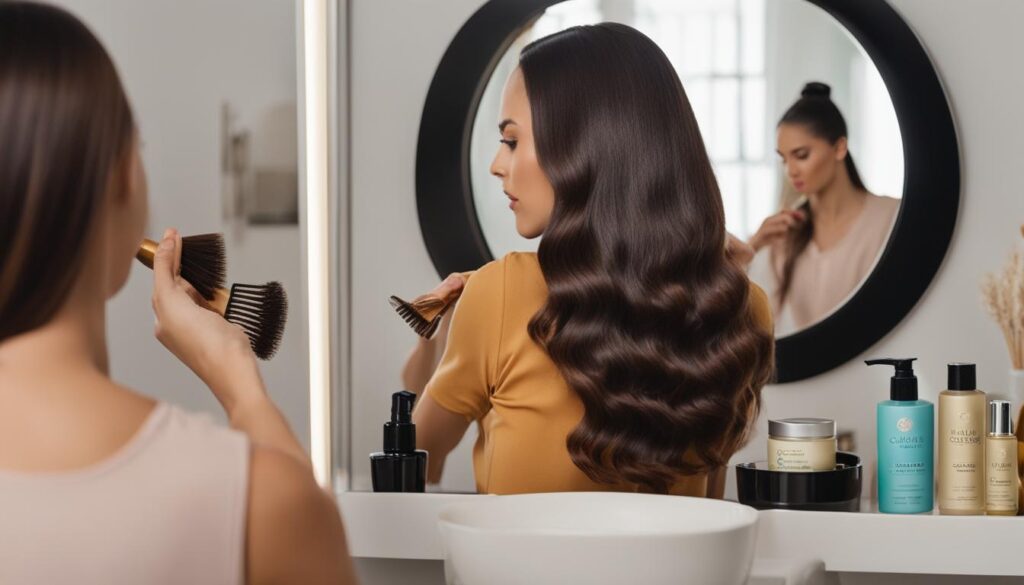Castor oil is a popular hair treatment known for its potential benefits for hair growth and overall hair health. Many people are eager to incorporate it into their hair care routine but are unsure about the frequency of use. In this article, we will discuss the recommended frequency for using castor oil hair masks, best practices, and important considerations for optimal results.
Key Takeaways:
- Applying castor oil hair masks one to two times per week for at least three months is recommended to see results.
- Consider your hair type and adjust the frequency accordingly.
- Those with fine, thin, or low-porosity hair may want to use castor oil less frequently to prevent buildup and greasiness.
- Coarse, thick, or dry hair can benefit from leaving castor oil in as an overnight treatment or using it as a leave-in conditioner.
- Experimentation and finding the right frequency for your hair type is key to achieving optimal results with castor oil hair masks.
Understanding the Benefits of Castor Oil for Hair
Castor oil offers several benefits for hair that contribute to its overall health and appearance. It is rich in anti-inflammatory fatty acids, antioxidants, and has antibacterial and antifungal properties.
These properties make castor oil an effective moisturizer that can hydrate dry skin and hair, soothe irritated scalps, reduce dandruff, and promote healthier hair growth. Castor oil also has a thick consistency that helps seal in moisture, adds shine to hair, and reduces frizz. While castor oil alone cannot increase hair growth, when used regularly and in conjunction with a comprehensive approach to hair care, it can contribute to maintaining healthy hair and scalp.
“Castor oil is rich in anti-inflammatory fatty acids, antioxidants, and has antibacterial and antifungal properties.”
How to Use Castor Oil for Hair
Using castor oil for hair is relatively simple, but there are a few key tips to keep in mind for optimal results. Here’s a step-by-step guide on how to use castor oil for your hair:
- Start by choosing a high-quality castor oil, such as cold-pressed or Jamaican black castor oil. These types of castor oil are known for their purity and effectiveness.
- Before applying the oil, warm it up in your palms to make it easier to spread and penetrate the hair. This will also help to activate the oil’s nourishing properties.
- Depending on your hair type and the area you want to target, you can apply castor oil to your scalp, hair strands, or both.
- If you’re applying castor oil to your scalp, massage it gently using circular motions. This will help stimulate blood flow and nourish the hair follicles.
- If you’re applying castor oil to your hair strands, focus on the mid-lengths and ends. This will help seal in moisture, prevent breakage, and add shine to your hair.
- Leave the oil in for a minimum of two hours to allow it to work its magic. For an overnight treatment, wrap your hair in a silk scarf to prevent the oil from transferring onto your pillow.
- After the desired duration, wash out the oil using a clarifying shampoo. This will help remove any residue and leave your hair feeling clean and refreshed.
- Style your hair as usual, and enjoy the nourishing benefits of castor oil!
It’s important to note that castor oil can stain fabrics, so protecting your clothing and bedding is recommended during application.
| Pros | Cons |
|---|---|
| Hydrates dry hair and scalp | May be too heavy for fine or low-porosity hair |
| Promotes hair growth | Can be difficult to wash out |
| Reduces frizz and adds shine | May cause skin irritation in some individuals |
| Strengthens and nourishes hair | Can stain fabrics |
Using castor oil for hair can be a transformative addition to your hair care routine. By following these simple steps, you can harness the power of castor oil to achieve healthier, more lustrous hair.

Conclusion
Castor oil hair masks can be a valuable addition to your hair care routine, providing potential benefits for hair growth, moisturization, scalp health, and overall hair health. When used consistently and in conjunction with a comprehensive approach to hair care, including a healthy diet, proper hydration, regular exercise, and a gentle hair care routine, castor oil can help nourish and improve the condition of your hair.
While castor oil alone cannot guarantee miraculous hair growth, it can contribute to maintaining a healthy scalp and hair environment, which is essential for optimal hair growth. Experimenting with the frequency of applying hair masks with castor oil and the way you use it on your hair can help you determine the best approach for your specific hair type and goals.
Remember to choose high-quality castor oil to ensure the best results. Prioritize scalp and hair health, and be patient—significant changes in hair growth or appearance may take time. By incorporating castor oil hair masks into your routine and adopting a holistic approach to hair care, you can nurture your hair and enhance its natural beauty.
FAQ
How often should I use castor oil hair masks?
Experts recommend applying castor oil hair masks one to two times a week for at least three months to see results. Adjust the frequency based on your hair type and condition.
What are the benefits of castor oil for hair?
Castor oil offers several benefits for hair including moisturization, scalp health, reduced dandruff, and promotion of healthier hair growth. It can also add shine, reduce frizz, and seal in moisture.
How do I use castor oil for hair?
To use castor oil for hair, warm it up in your palms, then apply it to your scalp, hair strands, or both. Massage gently, leave it in for at least two hours or overnight, and wash out with a clarifying shampoo.
What are the best practices for castor oil hair masks?
Choose high-quality castor oil like cold-pressed or Jamaican black castor oil, protect your clothing and bedding from stains, and prioritize scalp and hair health for optimal results.
What kind of results can I expect from a castor oil hair mask?
With regular use, a castor oil hair mask can contribute to healthier hair, improved scalp condition, reduced dandruff, increased moisture, and potential promotion of hair growth. Results may vary depending on individual factors.




